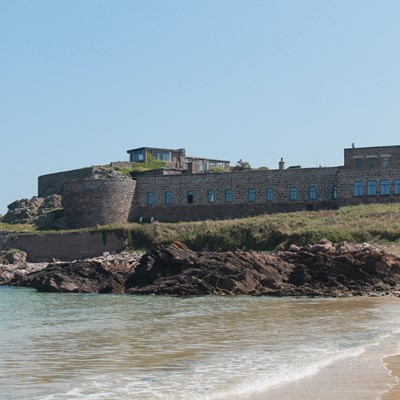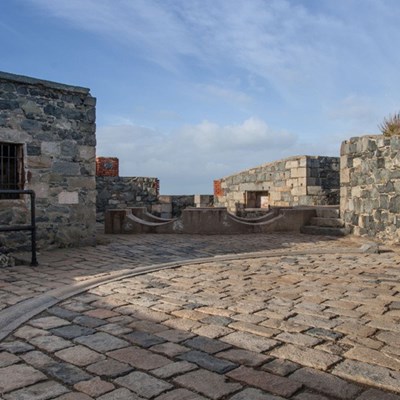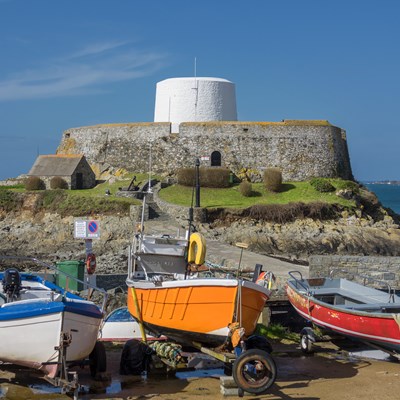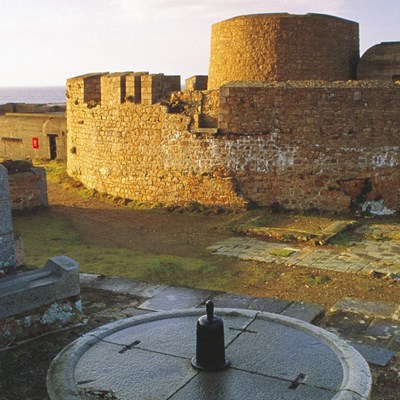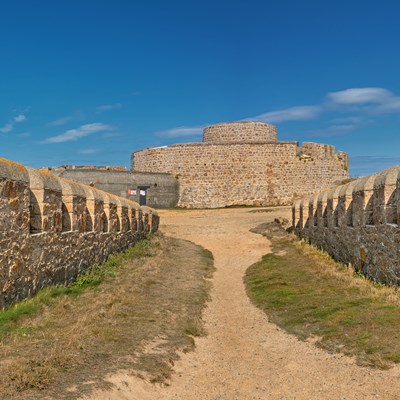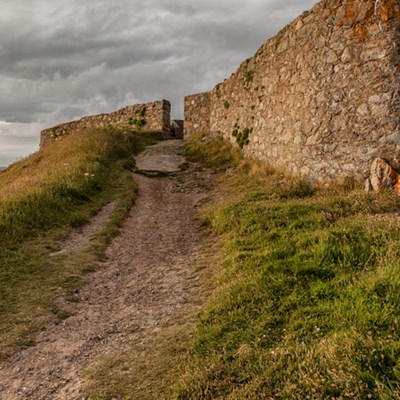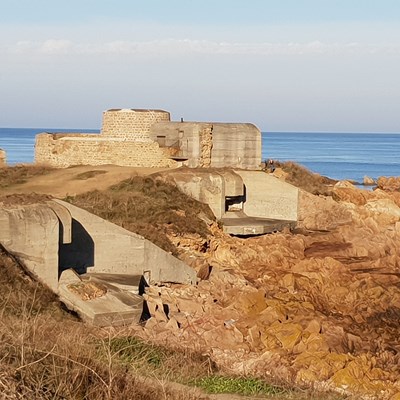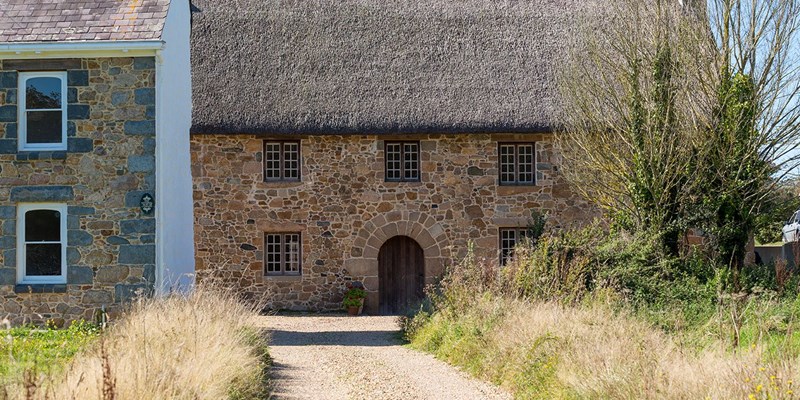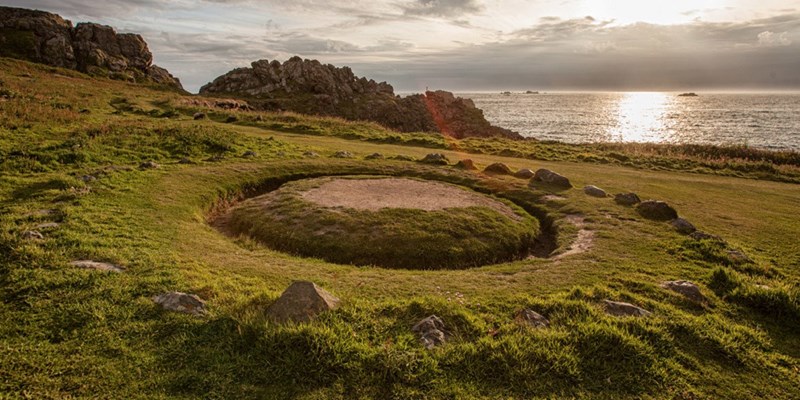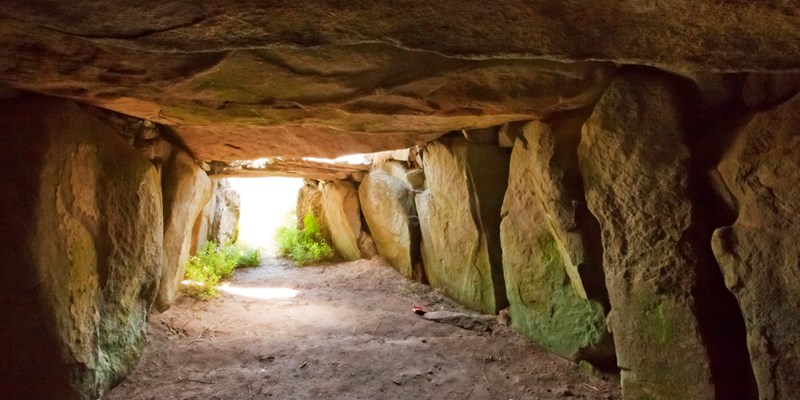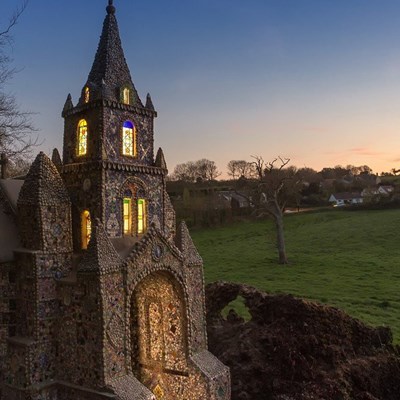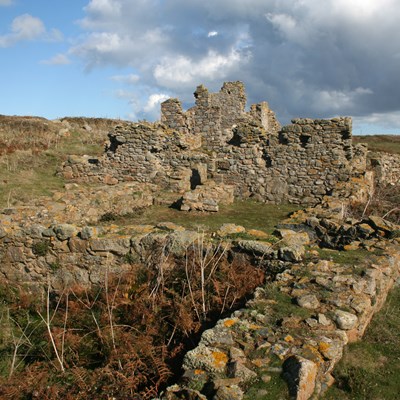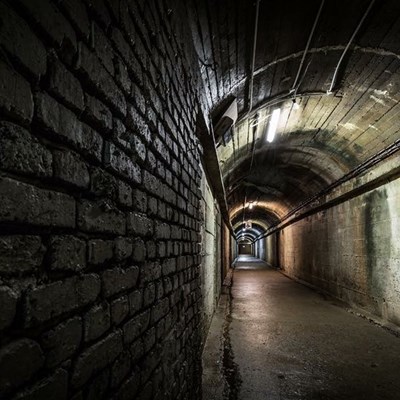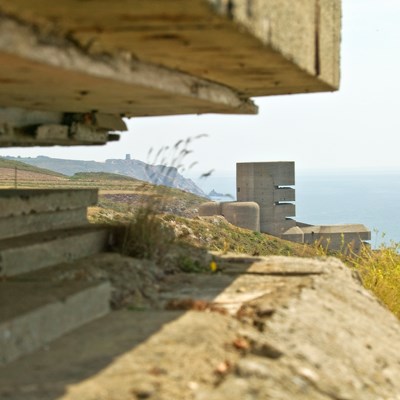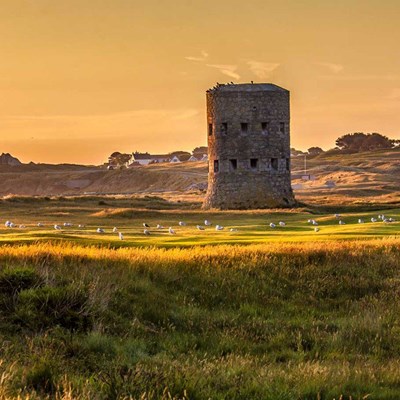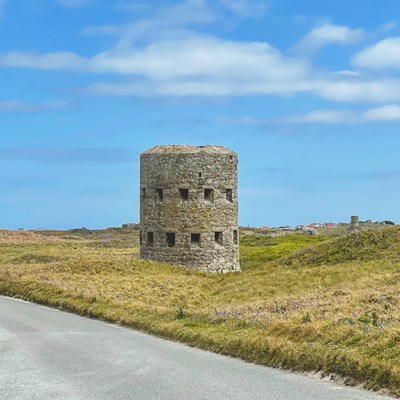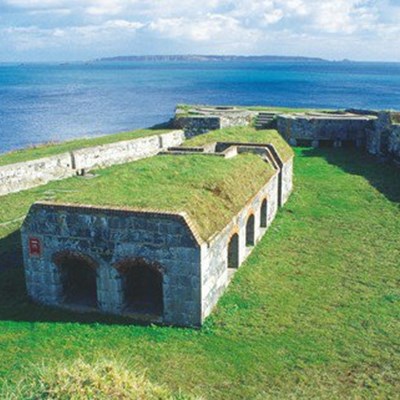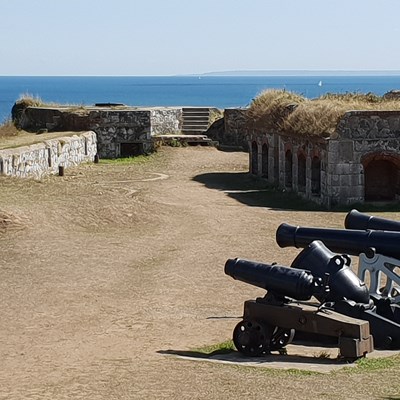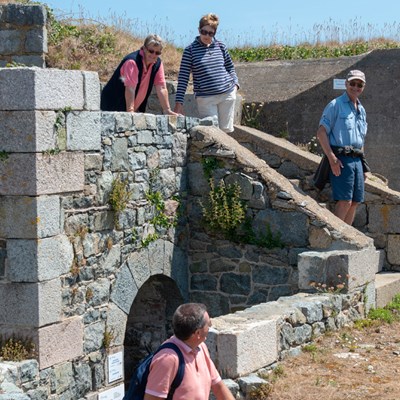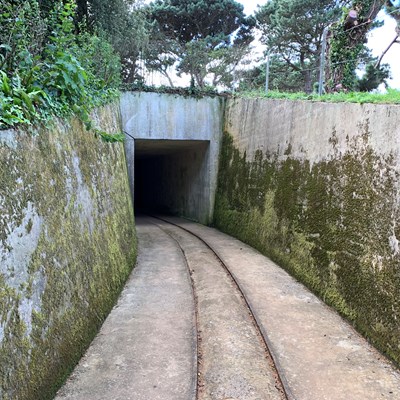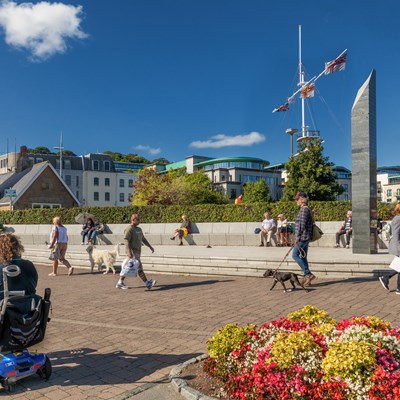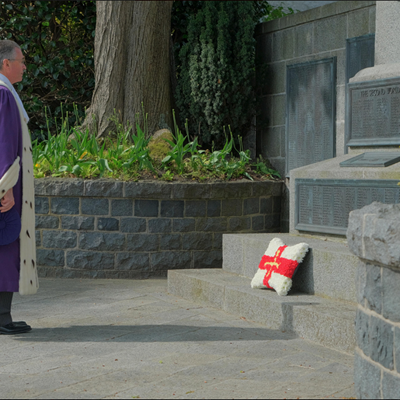Our Islands have a rich and varied heritage shaped by many different time periods, people and events.
Islanders celebrate and commemorate the past and how it has formed our Islands today, so you'll find many museums, heritage sites and sites of historical importance. From neolithic tombs and war-time structures to maritime sites and Norman forts, there's plenty to explore.
Forts and Castles
The Islands have many castles and forts that have been preserved. Some can be explored on your own and some have been turned into museums and educational places to visit and learn about the heritage of the Islands of Guernsey.
Castle Cornet
- Castle Cornet is an 800-year-old castle standing at the mouth of St Peter Port harbour and is the largest heritage site on our Islands. Just a short walk from the centre of St Peter Port, the castle offers a fascinating insight into hundreds of years of history, including the Story of Castle Cornet and its military history, five museums, four gardens and spectacular panoramic views of St Peter Port and our sister islands. The daily attractions include a free guided tour at 10.30am and at midday the Noonday Gun is fired by gunners in 19th-century costume.
Fort Grey and the Shipwreck Museum
- Known locally as the ‘Cup and Saucer’, Fort Grey is a Martello Tower on Guernsey's west coast next to Rocquaine Bay. It was built in 1804 as a defence against French invasion and now contains the island's Shipwreck Museum, where you can uncover stories of ships which came to grief on our coast.
Victoria Tower
- The tower was built in 1848 to commemorate Queen Victoria's visit to Guernsey on 24th August 1846, the first visit by a reigning monarch to the Islands of Guernsey. To visit the tower, ask for the secret key from the Guernsey Museum at Candie Gardens. You will be handed the original iron key that will give you access. You can head up the ninety-nine stairs to the top of the tower, which overlooks St Peter Port and out to sea. The view from the top is well worth the climb. Whilst there, look closely for the carved initials of exiled resident Victor Hugo and his lover Juliette Drouet, who used to meet in the tower in secret.
Vale Castle
- Vale Castle overlooks the northeast end of the island and has spectacular views of Herm and Jethou. It is open to the public throughout the year, is becoming a popular venue for music festivals and can be hired for private events. The history of the castle dates back to the Iron Age, but the earliest parts of the stone castle that we see today date to the 15th century. During the Second World War, the German occupying forces fortified the castle and the surrounding area, the remains of which can be seen today.
Roman Fort - The Nunnery
- Found just above Longis Bay in Alderney, ‘The Nunnery’ is the best preserved Roman small fort in Britain. It is the first evidence of military construction on our Islands and was originally built in the 4th century to defend the anchorage in Longis Bay harbour and the nearby Roman settlement. The fort is newly opened after undergoing major renovations and is now a museum documenting the history found here. There are storyboards, an information room, a large WWII bunker and more, with free admission daily.
Fort Doyle
- Built at Fontenelle Bay on the northern shore of Guernsey during the 19th century, Fort Doyle was part of the island-wide fortification network designed to protect the island against a French invasion. Originally, there were three 18-pounder cannons stationed in the battery in the fort, however, during World War Two the occupying German forces heavily fortified the area with three coastal defence guns, anti-aircraft guns and mortars.
Fort Hommet and Fort Hommet Gun Casemate
- Fort Hommet was a heavily defended headland with 12 German defensive structures. One bunker, which was built to house a 60cm searchlight was transformed by Hubert Le Galloudec who created a shrine within the bunker, decorated with shells collected from local beaches. The Fort Hommet Gun Casemate Bunker is a fully restored gun casemate. It is one of 21 ‘Fortress’ bunkers built in Guernsey and is open for visits on Tuesday and Saturday afternoons in the summer.
Fort Le Marchant
- A fort has stood on this site since at least 1680. At the end of the 18th century, when fears of a French invasion prompted new fortifications around Guernsey's coast, the original fortification was expanded. The work was completed in 1805 and the new fort was named after the then Lieutenant Bailiff Eleazar Le Marchant. Be aware of the colour of the flag flying as a rifle range is also located here and a red flag indicates the range is in use.
Fort Pezeries
- This is another site where a fortification of some sort has been located since at least 1680. During the 18th century, the gun platform was extended and steps added, the magazine was built and the parapet strengthened at a later date. By 1842 the fort had fallen into disrepair, but restoration work has partially restored the site and now there are three 18-pounder cannons overlooking Rocquaine Bay.
Star Fort
- Built in 1811, records indicate that 100 men were used in its construction and it mounted six guns, one on each point of the star. Unmodified examples or Star Forts like this one are rare so this is an important example of military engineering.
Historic Houses and Gardens
We are lucky to have some historic houses with beautiful gardens, many of which are open to the public to explore and enjoy.
National Trust of Guernsey Les Caches Farm
- Les Caches Farm is a collection of traditional Guernsey farmhouses and outbuildings dating from the 15th Century to the mid-19th Century, nestled amongst the countryside. The two-floor heritage building, with its adjacent orchard and fields, is available for private events and makes a particularly beautiful wedding location There are organised tours and group visits, with local guides imparting their knowledge of the farm and its history.
Government House and Garden
- Government House is the official residence of the Lieutenant-Governor, the personal representative of the Sovereign in the Bailiwick of Guernsey. The House is a large Georgian house on the outskirts of St Peter Port and is listed as a protected building. The grounds comprise 10 acres of parkland and landscaped gardens with over 150 mature trees, including a Blue Atlas Cedar planted by Queen Elizabeth II during a visit in 2001 and others planted to commemorate Royal visits, Jubilees and other notable occasions.
- There is an impressive collection of camellia cultivars of national significance, planted in 1997 to celebrate ten years of the local charity ‘Plant Heritage Guernsey’. The highlight is the historic walled garden, which is one of the best examples of a traditional walled garden in the British Isles, fully utilised to produce around a hundred varieties of fruits, vegetables, herbs and flowers for the kitsch and house.
Candie Gardens and the Guernsey Museum at Candie
- This rare example of a late 19th-century public flower garden is home to the oldest known heated glasshouses in the British Isles. In the gardens, aside from beautiful flowers, lawns and fish ponds, there is a museum and art gallery with a rolling programme of exhibitions, a cafe and gift shop housed in a Victorian bandstand and a statue of Victor Hugo.
Hauteville House
- The French writer, Victor Hugo, spent almost 15 years in exile in Guernsey during the 19th century and the house he lived in and decorated himself in St Peter Port house is well worth a visit. You will get the chance to see where he spent time writing some of his greatest masterpieces and explore the Gardens he tented to himself.
Sausmarez Manor
- Guernsey's only stately home, Sausmarez Manor is filled with the history of the island and the family who have owned it for more than 800 years. There are house tours, a sculpture park, a 9-hole pitch and putt course, a subtropical woodland garden and a miniature railway all within the grounds.
Ancient Sites
Guernsey boasts a fascinating history dating back to the Neolithic period. Many sites from this time remain well preserved and can be explored on your visit.
Le Creux ès Faïes
- Le Creux ès Faies is a well-preserved Megalithic passage tomb dated between 3,000 to 2,500 BC. It is known as the entrance to the Fairy Kingdom in Guernsey folklore. It is 9 metres long with a narrow entrance expanding into a round-ended chamber.
Table des Pions - The Fairy ring
- Local legend has the site linked with fairies, witches, elves and other mythical creatures, hence it is known locally as the Fairy Ring. Legend states that if you walk around the ring three times and make a wish, it will come true. In reality, the site was used as a dugout picnic bench by island officials when inspecting roads and coastal defences up until 1837.
Dehus Dolmen
- Dehus Dolmen is a ten-metre-long prehistoric burial chamber from the Neolithic period. It dates back as far as 3500BC and is believed to be the tomb of a Celtic chief. Look out for the stone carvings, which depict a bearded man and a large bow, known as the “Guardian of the Tomb”.
Albecq Medieval Settlement
- The remains of a small medieval settlement were excavated in 1995. The site was occupied in the late 14th and early 15th centuries and is now a documentation of Guernsey’s past.
Delancey Dolmen
- Delancey Dolmen consists of the remains of a collapsed megalithic structure. A row of massive granite slabs suggests some form of elongated chamber, although no stone remains upright, and, with the possible exception of a large slab at the east end, there are no capstones remaining. It is believed that other stones may still be buried in the hillside.
La Platte Mare
- La Platte Mare is a cist-in-circle, a small megalithic chamber enclosed within a small circular mound. It is 5 metres in diameter with a kerb of large slabs and boulders. One of the exceptional features of this site is a row of 12 curved cup-shaped marks on one of the stones.
La Varde
- This prehistoric passage grave is the largest and most impressive surviving megalithic structure on the Islands of Guernsey, built during the Neolithic period and discovered in 1811 when human skulls and bones were unearthed. From this site, there are stunning views from the site over L'Ancresse Bay and the Common.
Le Trépied Dolmen at Le Catioroc
- Another prehistoric passage grave built during the Neolithic period, this particular tomb was a notorious meeting place for the fabled Guernsey witches.
Les Fouillages
- One of the earliest monuments in Europe, the first structures of this complex burial monument were built about 6500 years ago. The site was excavated between 1979 and 1981 and over 35,000 finds were made, now on display at Guernsey Museum.
Chapels and Areas of Religious Importance
The Islands of Guernsey have had some impressive religious sites built throughout their history, from tiny chapels to preserved ruins that tell a fascinating story.
Little Chapel
- Quite possibly the smallest church in the world, The Little Chapel is a work of art built by Brother Déodat, who started work in March 1914. It measures just 19ft by 9ft, intricately decorated with seashells, pebbles and broken china.
Lihou Priory
- The Benedictine Priory on Lihou Island was founded in the 12th century. The church was highly decorated with carved limestone, painted window glass and a floor of yellow and green glazed tiles. Burials in the cemetery and church have been dated to c.1250. Many fine objects have been found, indicating the high status of the Priory. It is now in ruins but the outline of the buildings can clearly be seen.
St Apollines Chapel
- This is a rare example of a 14th-century chantry chapel, largely in its original form. The chapel was built around 1390 and is one of only two known sites with surviving medieval wall paintings in Guernsey. An ecumenical church service is held in the chapel each week.
German Fortifications and The Occupation
During World War Two, the Islands of Guernsey were invaded by the German army and occupied for five years. The Channel Islands were seen as a perfect stepping-stone to the invasion of Great Britain.
However, when it became clear this was not going to happen, the Islands were converted into a fortress as part of the Atlantic Wall. This included utilising older historical sites, battery's and fortifications built hundreds of years ago, adapted for new use. Reminders of the occupation and the effect that it had can still be seen around the island today.
German Underground Hospital
- The German Underground Hospital and Ammunition Store is the largest structural reminder of the German Occupation existing in the Channel Islands. This maze of tunnels (over 75,000 square feet) is almost invisible from the surface, except for the entrances. It is open to the public to explore from April to October.
German Occupation Museum
- Within walking distance of the island's airport, the German Occupation Museum provides insight into life in Guernsey during the occupation. You'll find a unique curation of objects and artefacts not found anywhere else in the world exploring the experience of Islanders, soldiers and prisoners from 1940-1945.
La Valette Underground Military Museum
- Located near La Valette Bathing Pools, La Valette Underground Military Museum covers Guernsey's military history, including World War One and the German Occupation of the island from 1940 to 1945 during World War Two, as well as the island's own militia.
Batterie Dollmann Command Post
- A large proportion of the Pleinmont headland was covered by the coastal artillery Battery Dollmann. Many of the fortifications can still be seen today. This bunker was the Leistand or Command Post. Above ground is the rangefinder position with a huge square concrete roof and it has two underground levels.
German Naval Signals Headquarters
- The Headquarters of the German Naval Commander in the Channel Islands were originally established at La Collinette and La Porte Hotels. A decision was later taken to build permanent bunkers at St Jacques. They were operative from 1st February 1944 and handled all the radio signals for the German Forces in the Channel Islands. The bunker has been restored and refitted and is now open to the public.
Chateau Des Marais
- The Chateau des Marais was first built in the early 13th century and refortified in the late 18th century when the magazine was built. During the Second World War, it was utilised by the Germans, who built a bunker within the inner walls.
Observation Tower, No.5 (Prevote Tower)
- This Army Artillery Observation Post is a two-storey tower high on the south coast cliffs. This was a watchhouse which was destroyed to build the tower, which was originally clad with granite to camouflage it as a Napoleonic tower.
Pleinmont Observation Tower
-
This unique five-story naval observation tower was built and used by German forces from 1942 to 1945, as part of their sea defence system during their occupation of Guernsey in World War Two. The original rangefinders are still onsite and in working order. There is also access to a battery dolmen gun-site nearby.
Loophole Towers
- 15 loophole towers were built around the island between 1778 and 1779 to protect some of the island's most vulnerable beaches from potential invasion. They are all of a standard design and make up a distinctive feature of our island's coastline.
- They can be found at L’Ancresse, Chouet, Rousse, Vazon Bay, Petit Bot, Saints Bay and other coastal spots.
Beaucette Battery
- Built around 1793 to help protect the northern approaches and the channel between Guernsey and Herm. Originally it mounted two 18-pounder cannons, but by 1816 mounted two 24-pounders and had been provided with a permanent magazine which is now lost.
Clarence Battery
- Constructed in 1780, Clarence Battery was built as one of the original outer defences of Fort George, Guernsey’s major military headquarters in the late 1780s. It was the island’s principal fort during the French Revolution and home of the German Luftwaffe early warning system during World War Two. The battery had a guard room, gun pivots, ammunition lockers, shell stories and artillery stores. Some of it remains, though some alterations were made during the occupation. It is well preserved and the elevated position gives it a spectacular view across St Peter Port and Castle Cornet, along with the Castle Breakwater.
Delancey Battery
- This battery held a strong defensive position, overlooking Belle Greve Bay, the Little Russel and the east coast of Guernsey. The barracks no longer survive but from this high vantage point the battery has spectacular views along the eastern coast of Guernsey.
Grandes Rocques Battery
- Constructed around 1779, it was armed with three 24-pounder guns and was serviced from a powder magazine located some distance from the battery. The battery was altered by the German occupying forces during the Second World War. There are gun positions and trenches across the site for everyone to enjoy exploring.
L'Eree Battery
- In 1801 this battery mounted two 18 ponder guns and would have guarded the northern side of L'Eree Bay. Today, two cannons stand on the site guarding the headland. There are spectacular views over to Lihou Island and Pleinmont Point.
Mont Chinchon Battery
- Mont Chinchon battery, also known as Druids Altar Battery due to its proximity to Le Trepied Dolmen, had two 20-pounder cannons which would have been manned by the Guernsey Militia. The site was dismantled by the German occupying forces to make way for more modern defences and after the 1940's the battery fell into disrepair. In 2006 work began to restore the battery which was completed in 2008.
Perelle Battery
- This battery provided extra protection to Perelle Bay as it sits between Mont Chinchon Battery and Fort Richmond. It mounted two 20-pounder guns and originally had its own magazine, but this has been destroyed. The battery has been partly reconstructed.
Rousse Battery and Magazine
- At Rousse, the tower and battery are uniquely combined in a single fortification. It stood guard over the western approaches to the Braye du Valle which once separated the Clos du Valle from the rest of Guernsey. In 1816 the battery had three 24-pounder cannons and two nine-pounder cannons. Replicas of these guns can be seen at the site today and there is an associated magazine to the southwest.
Tourgis Batteries
- Following recent extensive clearance and conservation work, the Cambridge Battery and Battery No.3 (part of the northern defences of Fort Tourgis in Alderney) are now open to the public. Information boards offer insights into the history of these batteries. You can wander through the old tunnels and immerse yourself in the history. The site is open to the public and a torch is advisable when exploring the tunnels.
Remembering Our Past
The history of Guernsey is incredibly important to Islanders. We have many memorials and monuments across our Islands commemorating our past, which can be visited at any time. These include:
- Island War Memorial: a tribute to islanders who lost their lives fighting in the First World War and was later extended to commemorate those who died fighting in WW2.
- Jewish Women's Memorial: dedicated to three Jewish women who were deported from Guernsey to their deaths in 1942.
- Sir Godfrey Carey Fountain: Memorial to Sir T. Godfrey Carey, Bailiff of Guernsey 1895 - 1902.
- South African War Memorial: bears the names of the 11 officers and 34 men who fell in South Africa.
- Val Des Terres Memorial Stone: commemorates the opening of the Val des Terres by the Prince of Wales, Prince Edward in July 1935.
- Fort George Military Cemetery: 3 graves from the First World War and 113 from the Second World War to commemorate those who lost their lives.
- Liberation Monument: commemorates the 50th anniversary (9th May 1995) of the Liberation of Guernsey from German occupying forces.
- Allied Aircrew Memorial: located outside Guernsey Airport Terminal Building, is in memory of 153 Allied Aircrew who lost their lives in Bailiwick waters.




